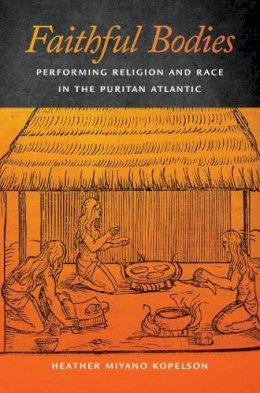
Faithful Bodies
Heather Miyano Kopelson
In the seventeenth-century English Atlantic, religious beliefs and practices played a central role in creating racial identity. English Protestantism provided a vocabulary and structure to describe and maintain boundaries between insider and outsider. In this path-breaking study, Heather Miyano
Kopelson peels back the layers of conflicting definitions of bodies and competing practices of faith in the puritan Atlantic, demonstrating how the categories of “white,” “black,” and “Indian” developed alongside religious boundaries between “Christian” and “heathen” and between “Catholic” and “Protestant.”
Faithful Bodies focuses on three communities of Protestant dissent in the Atlantic World: Bermuda,
Massachusetts, and Rhode Island. In this “puritan Atlantic,” religion determined insider and outsider status: at times Africans and Natives could belong as long as they embraced the Protestant faith, while Irish Catholics and English Quakers remained suspect. Colonists’ interactions with indigenous peoples of the Americas and with West Central Africans shaped their understandings of human difference and its acceptable boundaries. Prayer, religious instruction, sexual behavior, and other public and private acts became markers of whether or not blacks and Indians were sinning Christians or godless heathens. As slavery became law, transgressing people of color counted less and less as sinners in English puritans’ eyes, even as some of them made Christianity an integral part of their communities. As Kopelson shows, this transformation proceeded unevenly but inexorably during the long seventeenth century.
Product Details
About Heather Miyano Kopelson
Reviews for Faithful Bodies
Ann M. Little,Colorado State University "This is a fascinating and important new perspective on the body of Christ in early America. With meticulous research and illuminating insight, Kopelson reveals the chain of associations that bound religious communities and colonial societies to an emerging Protestant ethos committed to defining and disciplining corporeal life. Finally, we have a satisfying account of the Puritan attitude to race and sex."
Vincent Brown,Charles Warren Professor of History, Harvard University "The author of this study makes an important contribution to a growing conversation about race and religion in the puritan Atlantic world."
The Historian
"Faithful Bodies offers a complex, nuanced, and rich description of the role that bodies played in shaping Atlantic-wide conversations about race and religion. . . . A remarkably erudite work of scholarship. . . . Richly detailed, intellectually sophisticated, and nuanced."
William and Mary Quarterly
"One of the most compelling recent accounts of the complexity of difference in the Atlantic world. . . . While the book is filled with insights ranging from subtle readings of the spiritual meaning of fish and cassava to the regulation of interracial sex, Faithful Bodies stands out in both its extended attention to multiple communities and its broad archive. . . . Kopelson is not content to claim one methodological subfield, and thus readers will find themselves moving, expertly, from interpretations of material remains to a subtle reading of seventeenth-century invocations of the curse of Canaan. . . . In her attention to language and its implication in the material, social, and cultural worlds, she demonstrates that histories need to do more than adhere to disciplinary restrictions. To track differencesof race, of gender, of religionand thus to understand the modern subject is to move across the various registers of its constructionsomething Kopelson does better than most."
Journal of American History
"By focusing on bodiesthe ways they worship and labor, the conditions under which they can and cannot reproduce, the punishments they undergoKopelson is able to draw persuasive connections between many different sites of racial and religious formation, ranging from the pearl diving performed by Indians and Africans off the coast of Bermuda to the punishments meted out for fornication a century later in North America."
Early American Literature
"Wide ranging but at times incredibly detailed, Faithful Bodies describes the many kinds of embodied devotion and worship that had implications for how Atlantic Puritan communities understood race."
Early American Literature
"Heather KopelsonsFaithful Bodiesis a welcome and important addition to a growing body of literature on race, gender, and religion in the early modern Atlantic world. [] Kopelson has a subtle and careful eye for both religious ritual and gender performance that should be noted by scholars of race and religion who sometimes forget that the ideas and beliefs they are tracing were articulatedand policedby people who had bodies."
Church History and Religion Culture
"Kopelsons command of detail and careful inference certainly enhances her scholarly authority, and her ability to consistently present action and self-understanding from different points of view across such as wide range of subjects is commendable."
Church History
"As compelling as is the specific narrative about the coevolution of categories of religion, faith, and sexuality in the Atlantic world, the books biggest contribution may be the imaginative way Kopelson deploys archival resources to tell stories the archives themselves resist and conceal."
College Literature
"Kopelson deftly and creatively interacts in provocative ways with her sources. . . . Offers an innovative and much-needed look into the creation of racial identities in the colonial Atlantic. [Kopelsons] thoughtful and creative readings in Faithful Bodies ought to excite future scholars as they consider analyzing the nexus of racial identities and religious ideologies in the colonial worlds."
American Historical Review
